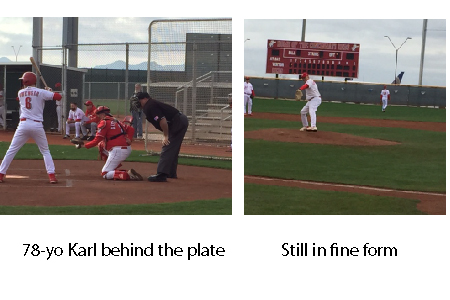Recently, I enjoyed my annual visit from Karl G who was featured in this video. At 78, he pitched another shut-out inning against the pros in his annual pilgrimage to the REDS spring training fantasy baseball camp.
[I pitched] one inning only but they did not score. We only play three innings against the pros and generally they only bat twice since they are home team and almost always win. I pitched the first inning – no runs. Another guy on my team pitched the 2nd and gave up a run and we lost 1-0.
He mostly played catcher this year and here are the pictures his wife, Joanne, took this year:
 Karl has been taking TA-65 since 2011 and measuring his telomeres with qFSH by Repeat Diagnostics and Life Length.
Karl has been taking TA-65 since 2011 and measuring his telomeres with qFSH by Repeat Diagnostics and Life Length.
Measuring telomeres presents some difficulties because unlike specific genes that have a unique sequence, they are just six base pairs repeated: TTAGGG. The most commonly used method of measuring them, including in almost all research papers, is called quantitative PCR. It is popular because it is cheap and any lab with a grad student can do it.
This year, Karl had a lot of anxiety about a very poor telomere result he obtained from his TeloYears $89 test (a qPCR method). Since 2011, he has been getting his telomeres measure by a different method, the flowFSH method of Life Length. His Life Length result was in line with previous years and this reassured him.
If you received a disappointing qPCR test from TeloYears or Spectracell, you might not want to despair. The measurement reliability with qPCR are pointed out in this important paper by Gutierrez-Rodrigues et al, one of many that casts doubts upon the relative reliability of the technique when compared with quantitative fluorescent in-situ hybridization FISH. TRF is the gold standard.
N.B. R-squared measures correlation: R-squared = 0.00 would be like the correlation between your body weight and the number of letters in your name; An R-squared of 1.00 would be your weight measured in kilograms versus you weight measured in pounds.
Now here is the abstract from the Brazilian paper comparing telomere measuring techniques:
TRF and flow-FISH [similar technique to Repeat Diagnostics and Life Length] showed good agreement and correlation in the analysis of healthy subjects (R2 = 0.60; p<0.0001) and patients (R2 = 0.51; p<0.0001).
In contrast, the comparison between TRF and qPCR [similar technique to TeloYears or SpectraCell] yielded modest correlation for the analysis of samples of healthy individuals (R2 = 0.35; p<0.0001) and low correlation for patients (R2 = 0.20; p = 0.001); qPCR sensitivity (40%) and specificity (63%) to detect telomeres below the tenth percentile were lower compared to flow-FISH (80% sensitivity and 85% specificity). In the clinical setting, flow-FISH was more accurate, reproducible, sensitive, and specific in the measurement of human leukocyte’s telomere length in comparison to qPCR. In conclusion, flow-FISH appears to be a more appropriate method for diagnostic purposes.
Keep in mind that this paper used a generic flowFSH technique and that I am privy to some of the validation research of Life Length. According to their data, they have a 96% correlation with TRF with their version 3.5 iteration of the same technique. To hear more about their company, available through clinicians like myself, watch this video:
If you are interested in a more detailed explanation of measuring telomeres, you can watch my video and review these slides by Dr. Bill Andrews.

